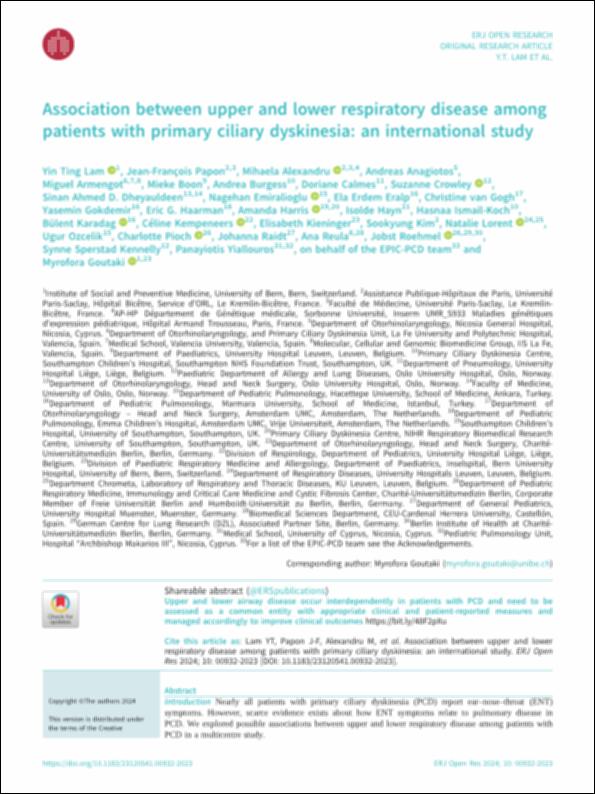Please use this identifier to cite or link to this item:
http://hdl.handle.net/10637/16442Association between upper and lower respiratory disease among patients with primary ciliary dyskinesia: an international study.
| Title: | Association between upper and lower respiratory disease among patients with primary ciliary dyskinesia: an international study. |
| Authors : | Lam, Yin Ting Papon, Jean François Alexandru, Mihaela Anagiotos, Andrea Reula Martín, Ana |
| Keywords: | Enfermedad de las vías respiratorias; Respiratory disease; Disquinesia ciliar, Síndrome de - Diagnóstico.; Ciliary dyskinesia, Syndrome - Diagnosis.; Aparato respiratorio; Respiratory systems; Epidemiología; Epidemiology |
| Publisher: | European Respiratoy Society |
| Citation: | Lam, Y. T., Papon, J., Alexandru, M., Anagiotos, A., Armengot, M., Boon, M., Burgess, A., Calmes, D., Crowley, S., Dheyauldeen, SAD., Emiralioglu, N., Eralp, E. E., Van Gogh, C., Gokdemir, Y., Haarman, E. G., Harris, A., Hayn, I., Ismail-Koch, H., Karadag, B., Kempeneers, Céline, Kieninger Goutaki, M. (2024). Association between upper and lower respiratory disease among patients with primary ciliary dyskinesia: an international study. ERJ Open Research, 10(2), art. 00932–02023. https://doi.org/10.1183/23120541.00932-2023 |
| Abstract: | Nearly all patients with primary ciliary dyskinesia (PCD) report ear-nose-throat (ENT) symptoms. However, scarce evidence exists about how ENT symptoms relate to pulmonary disease in PCD. We explored possible associations between upper and lower respiratory disease among patients with PCD in a multicentre study. Methods We included patients from the ENT Prospective International Cohort (EPIC-PCD). We studied associations of several reported ENT symptoms and chronic rhinosinusitis (defined using patient-reported information and examination findings) with reported sputum production and shortness of breath, using ordinal logistic regression. In a subgroup with available lung function results, we used linear regression to study associations of chronic rhinosinusitis and forced expiratory volume in 1 s (FEV1) accounting for relevant factors. Results We included 457 patients (median age 15 years, interquartile range 10-24 years; 54% males). Shortness of breath associated with reported nasal symptoms and ear pain of any frequency, often or daily hearing problems, headache when bending down (OR 2.1, 95% CI 1.29-3.54) and chronic rhinosinusitis (OR 2.3, 95% CI 1.57-3.38) regardless of polyp presence. Sputum production associated with daily reported nasal (OR 2.2, 95% CI 1.20-4.09) and hearing (OR 2.0, 95% CI 1.10-3.64) problems and chronic rhinosinusitis (OR 2.1, 95% CI 1.48-3.07). We did not find any association between chronic rhinosinusitis and FEV1. Conclusion Reported upper airway symptoms and signs of chronic rhinosinusitis associated with reported pulmonary symptoms, but not with lung function. Our results emphasise the assessment and management of upper and lower respiratory disease as a common, interdependent entity among patients with PCD. |
| Description: | Este artículo se encuentra disponible en la siguiente URL:https://publications.ersnet.org/content/erjor/10/2/00932-2023 |
| URI: | http://hdl.handle.net/10637/16442 |
| Rights : | http://creativecommons.org/licenses/by-nc/4.0/deed.es Open Access |
| ISSN: | 2312-0541 (Electrónico) |
| Issue Date: | 24-Nov-2023 |
| Center : | Universidad Cardenal Herrera-CEU |
| Appears in Collections: | Dpto. Ciencias Biomédicas |
Items in DSpace are protected by copyright, with all rights reserved, unless otherwise indicated.


